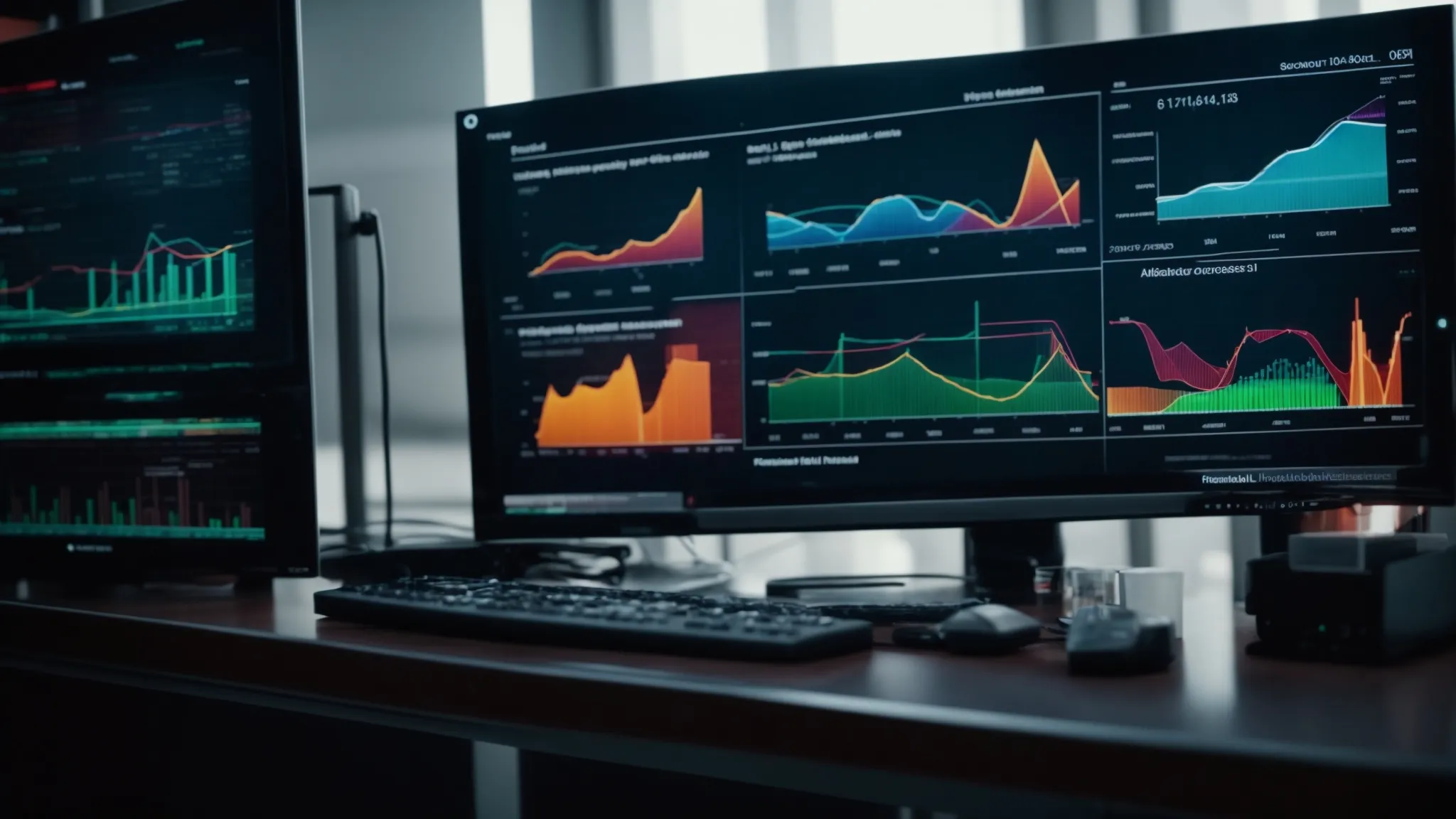
AVA's Insights
Unlock business brilliance with GridTier's latest features, indispensable best practices, and dynamite marketing strategies! Keep your edge sharp – follow our blogs for the newest updates.


What Is Automation Marketing?
Plunge into the dynamic world of automation marketing, a sphere where precision meets innovation to streamline your digital outreach efforts.
It's a realm constantly evolving, with savvy marketers harnessing cutting-edge tools to nurture leads, personalize communication, and measure success with unprecedented accuracy.
Embrace the transformative power of technology, allowing you to focus on creative strategies as the automated systems manage the heavy lifting.
Keep reading to unlock the full potential of automation in your marketing endeavors, enhancing efficiency and expanding your brand's reach.
Key Takeaways
Marketing Automation Revolutionizes Customer Engagement and Scales Business Growth
Personalization Through Automation Results in Higher Engagement and Trust-Building With Audiences
Continuous Evaluation and Adaptation of Marketing Campaigns Are Vital for Sustained Success
Advances in AI and Machine Learning Are Set to Further Personalize and Optimize Marketing Automation
Strategic Planning and Clear Objectives Are Crucial When Implementing Marketing Automation
What Is Automation Marketing?

Zooming in on the terrain of modern marketing, automation stands out as an essential fixture.
Picture a world where routine tasks are handled by intelligent software, leaving marketers more time to craft impactful strategies and interact with individuals who genuinely need their attention.
This is the core of automation marketing – a sophisticated mesh of technology that operates seamlessly behind the scenes to foster leads, personalize communications, and analyze data.
It's a space where algorithms and human creativity intersect to elevate the efficiency and effectiveness of marketing campaigns.
Peeling back the layers, we'll discover the key components that breathe life into this dynamic domain, paving the path to a deeper comprehension of how these systems revolutionize the approach to customer engagement and business growth.
Exploring the Basics of Automation Marketing
Embarking on a journey through automation marketing begins with understanding its foundational elements. At its heart lies the ability to streamline repetitive processes using advanced software, granting marketers the luxury of allocating their time and energy towards more strategic endeavors.
Tools integral to automation marketing are designed with sophistication to recognize, react, and nurture relationships with prospects and customers across various touchpoints. This allows for a more tailored and responsive interaction model, enhancing the overall experience while driving operational efficiency to new heights.
Key Components That Define Automation Marketing
Traversing further into the anatomy of automation marketing reveals its core - sophisticated software systems. These platforms not merely automate but also track and analyze every facet of marketing campaigns, from email outreach to social media engagement, crafting a cohesive journey for each prospect.
Another pillar is the data-driven decision-making process that lies at the crux of automation marketing. By harnessing the power of big data, these systems unveil patterns and preferences, allowing for hyper-personalized content delivery that resonates with the target audience, thereby bolstering conversion rates.
Exploring the ecosystem of marketing automation unlocks a panorama of potential; now, let’s step back and trace its dynamic ascent through time. Strap in, as we chart the transformative journey of marketing automation and its groundbreaking leap from concept to cornerstone.
The Evolution of Marketing Automation

Stepping back to trace the arc of progress in the realm of automation marketing, we're not merely witnessing an evolution, but a revolution.
My journey through the rich timeline of this field reveals a trajectory from straightforward email campaigns to the intricate software suites of today.
Technology, I've observed, wasn't a mere participant in shaping automation marketing; it was the catalyst, transforming it into the dynamic powerhouse that savvy marketers leverage to achieve unprecedented growth and scalability.
From Email Campaigns to Sophisticated Software
Reflecting on my experiences navigating the landscape of marketing technology, I recall a time when automation was synonymous with bulk email campaigns. These were the early days, when the prime objective was to spread a message far and wide, without the subtleties of today’s targeted approaches.
Now, as I engage with cutting-edge solutions, it's clear we've transitioned to a phase where automation tools offer a level of nuance once thought impossible. This leap is evident in platforms that not only intuit customer behavior but also adapt in real time, crafting personalized experiences at every digital juncture.
How Technology Has Shaped Automation Marketing
Reflecting on the synergy between technology and marketing, I've watched as big data analytics and machine learning have brought a transformative edge to marketing. These innovations have taken the guesswork out of campaign strategies, enabling precise segmentation and predictive analytics that fine-tune marketing efforts for maximum impact.
In my interaction with these cutting-edge tools, I've come to appreciate the real-time responsiveness that technology imparts to marketing automation. Gone are the days of static, one-size-fits-all campaigns; today's tools dynamically adjust content and messaging based on ongoing engagement, setting new benchmarks in personalized marketing.
As we pivot from the rich history that has shaped marketing automation, let's uncover what it truly brings to the table for today's businesses. Brace yourself for a revelation of the undeniable advantages that this technological marvel offers.
Core Benefits of Adopting Marketing Automation

Embracing marketing automation reaps a trio of transformative rewards.
Imagine amplifying your team's productivity by automating those time-consuming, yet vital, marketing tasks.
Meanwhile, deploying advanced technical insights to cultivate a unique experience for each customer sets a new standard in consumer engagement.
This strategic shift not only elevates the immediacy and relevance of connections with your audience but also equips your brand with the agility necessary to scale heights previously out of reach.
Knowing that these advantages are just the crest of the wave, it becomes clear why automation is heralded as a game-changer in contemporary marketing narratives.
Boosting Efficiency in Marketing Tasks
My firsthand experience in the marketing field has taught me that time is a commodity that's often in short supply. Embracing automation, I've witnessed teams reclaim hours, redirecting their focus from manual campaign management to strategic brainstorming and fine-tuning overarching marketing initiatives.
Through my continued use of automation tools, the transformation has been palpable; tasks that once bogged down my daily schedule, like lead nurturing and report generation, are now handled with impressive speed and accuracy by software solutions, giving me the ability to concentrate on innovation and creative projects that demand a human touch.
Enhancing Customer Experience Through Personalization
My approach to marketing has been fundamentally altered by the introduction of personalization through automation. Engaging customers now goes beyond broad strokes and into the realm of finely-tuned dialogue, speaking directly to individual preferences and behaviors that my tools can detect and act upon without missing a beat.
The nuance of personalization hasn't just spiked my campaigns' relevance, it has proven to be a beacon for building trust and rapport with my audience. Gone are impersonal tactics, replaced by meaningful interactions that resonate on a personal level, inviting a deeper connection to the brand that I represent.
Achieving Scalability in Marketing Efforts
Scaling a business involves magnifying its ability to engage with a wider audience without sacrificing the quality of that engagement. My use of automation marketing has proven instrumental in achieving that delicate balance, allowing the businesses I partner with to expand their reach while maintaining, or even improving, the personalization of customer interactions.
My role in tailoring automation tools helped marshal resources more effectively, enabling marketing campaigns to be more responsive and adaptive to market changes. This strategic application of technology ensures that growth objectives are not only met but also surpassed, as the automated systems provide the scaffolding for ambitious expansion.
Understanding the compelling advantages of marketing automation naturally leads us to question which tools can turn this potential into reality. Let's shift our focus to the instruments that power these benefits, unveiling essential platforms that transform marketing strategies.
Essential Marketing Automation Tools and Platforms

My exploration into the realm of automation marketing wouldn't be complete without shedding light on the arsenal of tools and platforms that make it all possible.
These technological marvels are the engines that power our strategies, enabling us to execute complex marketing operations with precision and ease.
In the upcoming discussions, a critical evaluation of the most celebrated automation software will unfold, alongside a breakdown of the pivotal features that distinguish exceptional tools from the ordinary.
Each solution boasts a unique set of capabilities designed to enhance efficiency, and I will endeavor to distill the essence of what makes a tool indispensable for marketers aiming to thrive in a tech-driven landscape.
Comparing Popular Automation Software
Navigating the expansive array of automation software, I've come to learn that each platform has its unique strengths that cater to diverse marketing needs. For example, some tools specialize in providing comprehensive workflows and CRM integration, which are indispensable for managing complex customer journeys and maintaining tight synchronicity between sales and marketing departments.
In comparing these platforms, I also pay close attention to the user experience they offer and their adaptability to a company's evolving needs. From sleek user interfaces to customizable features, the standout software is that which aligns closely with a marketing team's workflow, allowing for seamless adoption and minimal disruption in their pursuit of campaign excellence.
Key Features to Look for in Automation Tools
As I delve into the intricacies of selecting the finest automation tools, it's imperative for me to emphasize the importance of workflow automation capabilities. The ideal tool must offer a seamless way to create, manage, and optimize marketing tasks, helping to ensure the right messages reach the right audiences at the optimal times without demanding manual oversight.
Interfacing with numerous systems, I've noted that tools with advanced segmentation facilities stand out. The power to categorize leads based on behavior, demographics, or engagement level enables me to tailor campaigns that resonate profoundly with different segments of the market, thereby enhancing the potential for conversion and retention.
Armed with the right tools, it's time to craft a masterful marketing automation playbook. Buckle up; let's channel that arsenal into a bulletproof strategy.
Planning Your Marketing Automation Strategy

Embarking on the journey of automation in marketing demands a meticulous strategy, akin to plotting a course before setting sail on the vast digital ocean.
Crafting a blueprint tailored to your vessel – your business – calls for a compass and a map: the goals and metrics that will guide your passage.
My focus now turns to anchoring your enterprise in these waters by setting defined objectives, pinpointing key metrics to measure progress, and weaving automation seamlessly into the broader tapestry of your marketing endeavors.
Recognizing the correct course to steer is not just about unleashing the power of technology; it's about synchronizing it with your marketing chorus, each element working in concert to create a symphony of success.
Setting Clear Goals for Automation
Embarking on the implementation of marketing automation, it's paramount that I anchor my strategy in clear, measurable objectives. These targets become my north star, guiding every automated message, workflow, and campaign with the precise aim of driving engagement, conversion, and ultimately, revenue.
In my strategy development, I ensure that each goal is not just a distant dream, but a tangible, quantifiable milestone. Whether it's boosting lead generation by a certain percentage or achieving a defined increase in customer lifetime value, setting these explicit aims affords me the focus needed to harness the full potential of my marketing automation efforts.
Identifying Key Metrics for Success
Pinpointing the appropriate metrics to gauge the triumph of an automation marketing strategy propels businesses toward their goals with precision. Engagement rates, open rates, and click-through rates stand as beacons, illuminating the efficacy of communication and the enticement of content.
Conversion rates and lead generation metrics emerge as tangible evidences of a successful automation strategy, spotlighting the potency of tailored content in transforming prospects into loyal customers. By keeping a vigilant eye on these indicators, I can swiftly adjust tactics to ensure the marketing machinery is finely tuned to the demands of our audience.
Integrating Automation Into Your Overall Marketing Plan
Integrating automation into the overarching marketing plan isn't a siloed effort; it must be a harmonious part of the entire strategy. My experience dictates that careful coordination between automation and traditional marketing initiatives ensures every automated action aligns with broader brand goals, creating a seamless user experience from automated emails to human interactions.
Within my marketing plans, automation becomes the thread that stitches together various campaign elements. By embedding automation deeply into the fabric of the marketing strategy, I create a responsive, intuitive system that anticipates customer needs, enriches their journey, and maintains brand integrity across all platforms.
Now that your blueprint for marketing automation is laid out, let's shift gears to optimization. Time to master the best practices that ensure your marketing engine runs like a dream.
Best Practices for Effective Marketing Automation

Adopting marketing automation can be a transformative move, yet it requires strategic finesse to reap its full benefits.
Tailoring messages to specific segments of your audience ensures that your campaigns strike the right chord, optimizing the chance for meaningful engagement.
Layering into this, the crafting of compelling content is not just an art but a necessity to captivate and maintain interest across automated touchpoints.
And, to keep the wheels of progress turning, regular examination and fine-tuning of campaigns are crucial steps - much like a gardener pruning and nurturing, to encourage the best possible growth of their plants.
Segmenting Your Audience for Targeted Campaigns
I've perceived audience segmentation as the bedrock of any fruitful automation marketing plan. By dissecting your market into distinct groups based on shared characteristics like browsing behavior, purchase history, or demographic specifics, you facilitate a direct communication pathway that resonates with each unique cluster.
Executing targeted campaigns by employing this categorization strategy, my outreach endeavors have become far more potent. Tailoring content and messaging to meet the specific needs and interests of each segment, I've not only witnessed a spike in engagement but a notable uptick in conversion rates as well, affirming the critical role of segmentation in automation marketing.
Creating Engaging Content for Automated Campaigns
My commitment to creating engaging content for automated campaigns hinges on the principle that each message should resonate as if it were crafted individually for the recipient. By infusing automated communications with a sense of authenticity and personal relevance, I've observed a profound difference in how my audience interacts with my brand. Crafting messages that reflect an understanding of their preferences and needs leads to not just capturing attention, but fostering loyalty.
In my pursuit of developing content for these campaigns, I prioritize precision and creativity. The content must align with an individual's journey and anticipate their inquiries, providing answers before they're sought. By doing so, the relationship between brand and consumer strengthens, as I ensure that each touchpoint reiterates an understanding of the customer’s desires and the solutions my brand can offer, making every interaction feel like a personal conversation.
Continuous Monitoring and Optimization of Campaigns
My commitment to the perpetual refinement of automation marketing campaigns is an acknowledgment that the landscape of digital interaction is constantly evolving. I allocate time to review analytics and performance data, ensuring that each campaign is not just launched but is also cultivated over time to maintain its relevance and efficiency in engaging the target audience.
By embracing the dynamic nature of this field, I am compelled to remain vigilant, ready to tweak and enhance campaigns whenever data signals a shift in user behavior or campaign performance. This proactive stance enables me to ensure that marketing efforts are not stagnating but are instead persistently optimized to meet the ever-changing demands of the digital ecosystem.
Shifting gears, let's consider the ripple effects of marketing automation. Imagine peeling back the layers of customer interactions to reveal the transformative power of automated touchpoints.
Analyzing the Impact of Automation on Customer Engagement

Diving into the heart of automation marketing, my focus sharpens on its profound influence over customer engagement.
With a trove of data at my fingertips, I unravel the subtleties of customer behavior, gleaning insights that inform every nuance of the customer journey.
Leveraging these analytics aids me in sculpting a path towards more robust customer retention, ensuring each interaction is not just a transaction, but a step in building a lasting relationship.
Here, automation serves as my steadfast ally, empowering me to anticipate needs and preferences, fostering a sense of loyalty that transcends the fleeting nature of one-time business exchanges.
Understanding Customer Behavior Through Analytics
Dissecting the vast currents of customer data, my foray into analytics serves as the lighthouse guiding the way to understanding intricate consumer patterns. Armed with these insights, automation marketing transforms into a strategic platform responsive to the nuanced fluctuations of customer behavior, allowing me to curate an experience that feels personally tailored to each individual.
The perpetual quest to decode the digital footprints left by consumers sharpens my ability to predict and respond to emerging trends, ensuring the automation tools I employ are not just echoing past successes but are also aligned with evolving preferences. This vigilant adaptation to analytics infuses each campaign with the foresight needed to remain pertinent in an ever-shifting market landscape.
Leveraging Automation for Improved Customer Retention
Engaging with automation has revolutionized the way I foster customer loyalty. By implementing sophisticated systems that track purchasing habits and engagement, I've been able to trigger timely, relevant communications that keep customers connected to the brand long after the initial sale.
Through my experience, strategic use of automation creates a cycle of positive customer experiences that not only encourages repeat business but turns customers into passionate advocates for the brand. This has empowered me to elevate customer retention in a manner that feels both personal and scalable.
The ripple effects of automation on customer engagement are just our starting point. Let's shift our focus to what lies ahead - the horizon of marketing automation is brimming with innovations.
Future Trends in Marketing Automation

As I cast my gaze toward the horizon of automation marketing, I see the dawn of a new era precipitated by the continued ascent of artificial intelligence and machine learning.
These advancements stand poised to redefine the landscape of automation tools, shaping a future where marketing strategies become increasingly intelligent and adaptive.
In the forthcoming discussion, I will share my perspective on the transformative possibilities these technologies hold and the ways in which they are set to innovate the mechanics of automation marketing, taking us toward an era of even more personalized and efficient marketing methodologies.
Predictions for the Next Generation of Automation Tools
Gazing into the crystal ball of marketing innovation, I foresee the next wave of automation tools being deeply intertwined with artificial intelligence, offering far more than just streamlined workflows. These tools are expected to provide predictive analytics capabilities, enabling marketers like myself to anticipate consumer needs and respond with unprecedented precision.
Anticipating the future, I predict that these nascent tools will not only refine personalization but will also possess the agility to self-optimize campaigns in real time, capitalizing on every micro-moment of user interaction. This leap forward promises to dramatically enhance the connectivity between brands and their audiences, forging bonds that are both enduring and deeply rooted in data-driven insights.
How AI and Machine Learning Will Transform Marketing Automation
Envisioning the future trajectory of automation marketing, it’s clear AI and machine learning herald a seismic shift. They will empower automation platforms to not just react to consumer actions but to anticipate them, enabling me to craft campaigns that respond to the future needs of customers with striking accuracy. This forward-thinking approach is the cornerstone of a revolution in customer relationship management.
With the integration of AI, I foresee a transformation in personalization where machine learning algorithms refine customer profiles to an unprecedented degree. My role as a marketer will evolve, focusing less on pattern recognition and more on strategic deployment of AI's analytical outputs to deliver content that aligns with individual consumer journeys, resulting in richer, more meaningful brand interactions.
Frequently Asked Questions
What exactly does automation marketing entail?
Automation marketing, at its core, streamlines the digital marketing process through sophisticated software. This strategy empowers businesses to engage with customers more effectively, nurturing leads through personalized, timely communications.
How has marketing automation evolved over time?
Marketing automation has blossomed from a simple email scheduling tool to an intricate platform intertwining AI, big data, and predictive analytics that personalizes and streamlines the customer journey. Its evolution mirrors the crescendo of customer expectations and the relentless pace of technological innovation.
What are the main advantages of using marketing automation?
Marketing automation paves the way for enhanced efficiency by streamlining critical marketing tasks, allowing teams to focus on more strategic initiatives. It also fosters improved customer relationships through personalized and timely engagement.
Which tools are essential for implementing marketing automation?
Navigating the vast landscape of marketing automation tools can feel like steering a ship through foggy waters, with countless options obscuring the view to clarity. For businesses seeking to enhance their marketing efforts, it's vital to identify the tools that not only promise ease and efficiency but also deliver tangible results.
Email automation software is the mast of the marketing automation ship, keeping communication consistent and sails billowing with targeted messaging. Picture crafting personalized emails that reach your audience at the most opportune times, propelling your campaigns forward with precision.
Venturing further, customer relationship management (CRM) platforms serve as the compass guiding through customer interactions. By meticulously tracking engagements and preferences, these systems ensure that teams can tailor their approach, nurturing leads and fostering loyalty with remarkable insight.
Social media management tools, much like a skilled crew, are indispensable for maintaining a strong presence across the social seas. They provide the capability to schedule content, engage with followers, and glean analytics that help refine social strategies.
Lastly, for the treasure hunters keen on insights, analytics tools shine a light on the effectiveness of marketing efforts. They reveal the hidden gems within the data, allowing marketers to tweak campaigns for better performance and ROI.
In essence, selecting the right marketing automation tools involves a careful blend of functionality, compatibility with existing systems, and the promise of delivering on your specific marketing objectives. Choose wisely, and you'll chart a course for marketing success.
Can marketing automation improve customer engagement metrics?
Certainly, marketing automation stands as a potent tool, adept at enhancing customer engagement metrics through personalized communication and timely interactions. Utilizing data-driven tactics, it can significantly uplift the quality of engagement across various stages of the customer journey.
Conclusion
Grasping the intricacies of automation marketing is essential for revolutionizing customer engagement strategies and driving measurable business growth.
By adopting sophisticated tools powered by AI and machine learning, marketers gain the ability to tailor impactful communications and optimize campaigns with precision.
This approach not only enhances productivity but also paves the way for crafting personalized customer experiences that foster loyalty and advocacy.
As technological advancements continue to shape the marketing landscape, understanding and implementing automation becomes indispensable for staying competitive and nurturing lasting customer relationships.

Unify, Simplify, Amplify with GridTier.
Copyright © 2024 GridTier All rights reserved.
